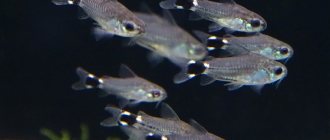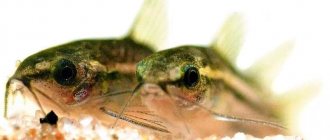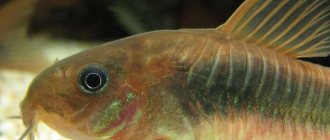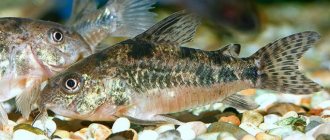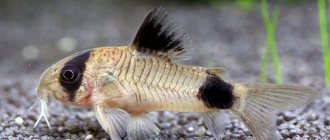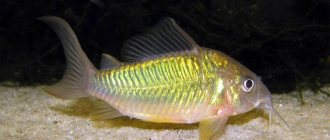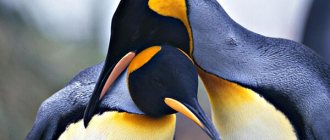04/20/2019Pisces0
Corydoras venezuelanus is a catfish belonging to the Callichtidae family. An active and playful fish native to Venezuelan rivers.
- 1 Description and natural habitat
- 2 Mr. Tail Recommends: Varieties
- 3 Basics of aquarium keeping
- 4 Compatibility
- 5 Feeding
- 6 Reproduction
Range and Habitat
South America reservoirs of Venezuela.
Corridoras Venezuela orange (C. venezuelanus) distribution areas.
This species is widespread in the lower reaches of streams and rivers in the Rio Tuy River and Lake Valencia basin in northern Venezuela in the States of Miranda, Aragua and Carabobo. It can also be found in nearby Orinoco rivers and streams such as the Rio Chirgua.
This is a species that prefers cooler waters and is never found on the plains.
Corydoras venezuelanus habitat.
Its natural habitat is cool, clear water with a neutral pH and moderate hardness. The flow in most of these streams is fast, and the substrate is typical of high mountain streams (rounded rocks and gravel).
General information
Corydoras aeneus "Venezuela Orange" is a freshwater tropical fish from the armored catfish family. According to modern research, the fish is a geographical morph of the golden or bronze corydoras (Corydoras aeneus), formed in several isolated reservoirs of Venezuela - the Rio Tuy river system and Lake Valencia. Some scientists consider the fish to be a separate species.
Despite the controversy among taxonomists, the fish is one of the most attractive corydoras, although in many regions it is quite difficult to purchase, and the price is sometimes quite high compared to its more popular relatives.
The main feature of the Corydoras Venezuela Orange is its stunning body color. The fish will never go unnoticed, thanks to the orange spots on its body, which contrast perfectly with the metallic sheen of the rest of its scales.
Otherwise, this is a typical corydoras, which is completely unpretentious in maintenance and gets along well with most types of tropical ornamental fish.
Corydoras Venezuela orange is characterized by intestinal respiration, so the fish need to float to the surface of the water from time to time to take another breath of air. If corydoras begin to do this very often, then this indicates a problem in the aquarium - there is no aeration or the water quality has deteriorated significantly.
Description
Has a large oval green or black patch covering the shoulder girdle and a distinct iridescent reddish-brown patch on the back of the head.
Corydoras venezuelanus appearance.
Commercially bred specimens may be shorter-bodied than their wild counterparts, and balloon-shaped varieties are available.
Size:
The maximum standard size of adult fish does not exceed 55 - 60 mm.
Diseases
The aquarium catfish Corydoras is characterized by strong immunity. There are no specific diseases characteristic of these catfish. Withstands significant fluctuations in environmental conditions. Do not use kitchen salt or sea salt to prevent pests.
Behavior and Compatibility
Peaceful and sociable, it is classified as a social species, so in order for its characteristic behavior to fully develop, it should be kept in a group of at least 4-6 individuals.
Corydoras Venezuela orange (C. venezuelanus) group of catfish.
Occupies the lowest level in the aquarium.
Corydoras venezuelanus (C. venezuelanus) is a peace-loving fish.
A calm and peaceful fish, it is better to select fish that are similar in size and behavior (characins and the like) as neighbors; you need to abandon aggressive neighbors.
Often the catfish rushes to the surface of the water because it is able to breathe atmospheric air in a manner similar to many labyrinths - this happens when there is a lack of oxygen in the water. Like other members of the family, fish of this genus have additional intestinal respiration and must have access to the surface of the water.
Appearance
Corridoras Venezuela orange has a body shape characteristic of its kind. It is short, with a rounded belly and a convex back. On the sides of the body, rows of plates are clearly visible, forming a kind of shell in catfish.
The mouth is lower, surrounded by three pairs of antennae, which are organs of touch and help catfish navigate in muddy water. It is also an excellent tool for digging in soft ground.
The main body color is rusty orange. Under the dorsal fin on both sides there is a large black (green) spot with a characteristic turquoise tint. There is a bright red spot on the head. The species is not large, the average size is about 5 cm, so these catfish can even be kept in nano-aquariums.
Life expectancy is up to 10 years.
Aquarium
Capacity from 50 liters, filtration and aeration are required to create a weak flow of water that imitates natural conditions, corydoras live mainly in small streams, ideally they use a substrate of fine sand, although rounded gravel is an acceptable alternative.
Corydoras Venezuela orange (C. venezuelanus) in aquarium 1.
Choosing a different decor largely comes down to personal preference; you can add some driftwood and small stones. Live aquarium plants will recreate the natural habitat and will be used by catfish as shelter.
Corydoras Venezuela orange (C. venezuelanus) in aquarium 2.
Prefers diffused lighting.
Water parameters:
Temperature: 21 - 27° C pH: 6.0-8.0 Hardness: 7 - 20° dH
Good water quality should be maintained and the soil should be cleaned regularly; any deviation in water parameters leads to a deterioration in the well-being of the fish.
Aquarium Basics
For comfortable life of fish, it is necessary to create conditions as close as possible to natural ones. The Venezuelan Corridoras is very sensitive to changes in water quality, especially to an increase in nitrogen compounds in it.
Basic recommendations:
- The volume of the aquarium is at least 75 liters for 5-6 individuals.
- Good filtration.
- Weekly water change of 1/3 of the total volume.
- The temperature is +20…+24 °C for the orange type, for black – +23…+28 °C. If the aquarium contains both species, then maintain a temperature regime in the region of +23…+24 °C.
- Acidity 5-7
- Hardness from 5 to 10 dH.
- Dim lighting.
- Fine sand or pebbles on the bottom.
- Plants and driftwood for constructing shelters.
Breeding
For spawning, it is preferable to plant a group of fish at the age of 1.5 years (4-6 males and 2-3 females or 2-3 males and 1 female), which are kept separately for a week before this and fed intensively and variedly.
Spawning, both in general and in a small spawning aquarium with an air filter - airlift.
Frequent addition of fresh cool water stimulates spawning, low atmospheric pressure is also a stimulus.
The females begin to swim restlessly, pursued by the males. Then one of them stands sideways in front of the female’s head and releases milk, while the female at this time lays several eggs in the fins folded in a ladle and swims through this cloud. The female lays up to 300 eggs on leaves and hard objects. This process is repeated several times and can last from several hours to 3 days. At this time, it is recommended to feed the fish intensively so that they do not starve, because the female can eat the eggs.
After spawning, the fish are removed or the substrate with eggs is transferred to an incubator; if the eggs are deposited on the glass of the aquarium, they are carefully removed with a razor.
The incubation period is 3-6 days, the fry swim the next day. Starter food: live dust.
Corydoras venezuelanus (C. venezuelanus) adult.
The fry acquire adult colors very early.
Name of the fish
Short description
Latin name | Corydoras aeneus Venezuela var. Black - var. Orange |
Habitat in nature | Catfish are common in small bodies of water in the lower Amazon, from Trinidad to La Plata. |
Description | The fish belong to the family of armored catfish (family Callichthyidae). A shiny dark green stripe stretches along the body of the catfish, and above it there is a golden stripe. The head and back are dark brown. The abdomen is light yellow. |
Difficulty in content | Keeping catfish is not difficult. Aquariums can be used with a length of 60 cm. The soil is preferably sandy, since fish mainly take food from the bottom. They, like other representatives of the armored catfish family, are characterized by intestinal respiration, so they can live in oxygen-poor water. |
Feeding | |
Contents in the aquarium | Catfish have developed intestinal respiration, so they survive even in water poor in oxygen and polluted with organic matter. However, it is not worth subjecting cheerful and peaceful barbels to such tests. Still, he is more capricious than the usual speckled catfish. |
Compatibility | Catfish is an absolutely non-aggressive fish and can be kept together with peaceful fish of medium and small sizes. |
Sex differences |
Females reach size 6, males are slightly smaller and have a more slender body.
Reproduction
Breeding catfish is not difficult. The conditions in the spawning aquarium completely coincide with the conditions necessary for the reproduction of speckled catfish. The only difference is that Venezuela is more thermophilic. Group spawning. The ratio of males to females can be 1:1, but it is better if it is 2.3:1. The chemical parameters of the water do not matter. Very often, spawning can be triggered by a change in temperature (preferably an increase of 1-2 degrees) and a decrease in atmospheric pressure. Productivity is from 100 to 300 eggs. After spawning, the spawners are removed, and a compressor sprayer is installed near the eggs. After 2-3 days, the larvae emerge from the eggs. They turn into fry in 4-5 days (depending on the temperature). For normal development, it is recommended to feed the fry often and abundantly. It is very important to ensure that the water is not contaminated with organic matter. Catfish, and especially their fry, are very sensitive to sharp decreases in pH, which can be caused by organic pollutants. Starter feed can be Artemia nauplii, live dust, as well as specialized powdered feed.
Description of the fish:
Requirements and conditions for:
- Aquarium volume - from 20 liters.
- Temperature - 23 - 27 °C
- pH value – 6.0 – 7.8
- Water hardness – 4° – 24°
- Water movement - slow flow
Fish parameters:
- Size - up to 6 cm.
- Nutrition - food comes from the bottom of animal origin
- Life expectancy is 2-4 years.
Personal experience A little more capricious than speckled catfish. They can become clogged in the filter during strong currents.
Notes
This species may be confused with Corydoras aeneus, and indeed C. venezuelanus is generally considered synonymous with this species. However, it is believed that C. aeneus should be limited to the holotype form, which is native to the island of Trinidad. In addition, C. venezuelanus is restricted to two closed water systems (Rio Tuy and Lake Valencia) located north of the serrania del interior (Venezuelan mountain formation). This is the only measles in these waters.
Corydoras Venezuela black (C. Black Venezuela / schultzei) black form
This species is almost never exported from Venezuela. Because of its scientific name, it is often confused with another species with an equally complicated history, selectively bred in captivity - the “black form” (Corydoras Black Venezuela / Corydoras schultzei).
Recommendations
The aquarium fish Corydoras is suitable for both beginners and experienced aquarists. Possessing a peaceful character, it gets along well with many fish, except aggressive predators. Undemanding to environmental conditions. He spends most of his time at the bottom, rummaging in the soil, performing the function of an aquarium orderly. Easily reproduces in captivity. With proper care, it will delight its owners with offspring and live up to 15 years.
Previous
Varieties of Cichlazoma severum (false discus fish): content, types (red-spotted, red-shouldered, pearl), compatibility
Next
Varieties of Guppy reproduction: how it happens, how they give birth, how often, features, proper care in the aquarium
Great article 0
Where should Corydoras live?
The aquarium is preferably large, but, if necessary, it can live in 50 liters - there are no exact restrictions on this, the fish is small, it always has enough oxygen and space. Loves water without added salt, temperature from 19 to 24 degrees, it is advisable to keep the minimum value - the corridor will be active and healthy. At elevated temperatures, there is a high risk of contracting various diseases.
For a comfortable stay, it is necessary to create a special relief. There should be “canopies” of algae to create shade for the corydoras. Pits and various depressions at the bottom will not hurt; it is advisable that they be made of hard materials, for example, ceramic bowls, curved stones. They will be the best house for fish.
How to propagate
This is a rather complicated process, but they can be propagated. To do this, you need to select 5 males and 2 females, put them in different vessels for 6-7 days, then bring them together. The aquarium should have a lot of oxygen, the water should always be fresh, moderately cool, no more than 23 degrees. Under such conditions, females begin to actively swim through the clouds of milk that the males release in front of her. Fertilization occurs in 2-3 eggs. This process is repeated until the female has no eggs left. Next, we maintain the temperature at +25 degrees, constantly changing 20% of the water. After 5 days the fry will appear.
What to feed
Corydoras black Venezuela and all its varieties are omnivores. That is, they can go on a diet and eat algae, as well as eat fresh bloodworms. It is advisable to combine food, that is, give grass with “dietary” food one day, and feed meat the next day. You can give flakes, plant tablets, granules, artemia meat, daphnia. Development will be much faster from protein foods, so if you want your specimens to grow large, they need to be fed bloodworms and worms.
